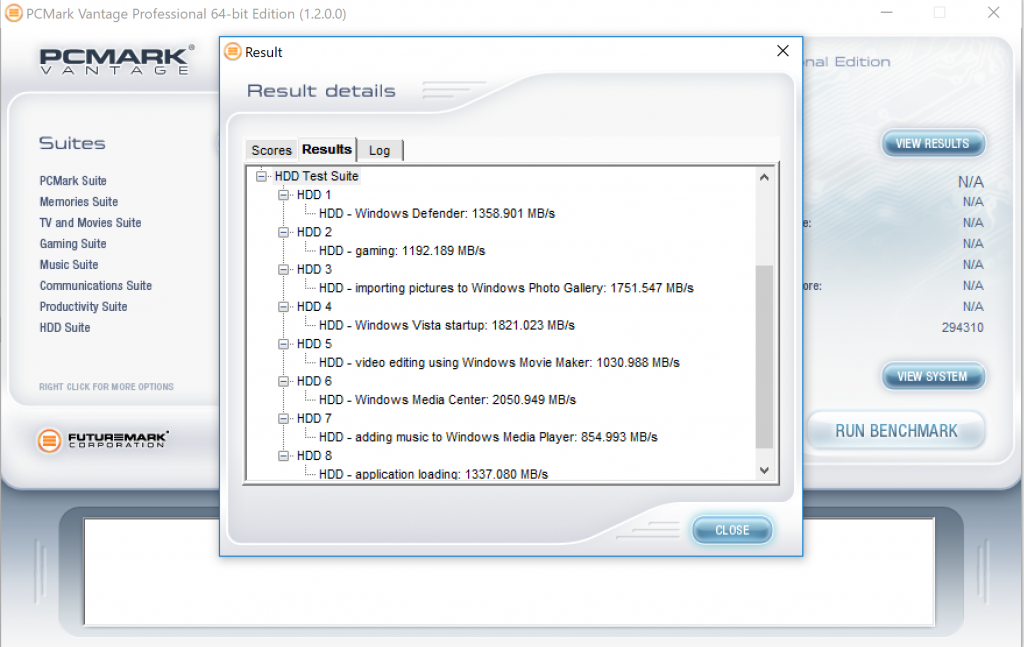The SSD Review uses benchmark software called PCMark Vantage x64 HDD Suite to create testing scenarios that might be used in the typical user experience. There are eight tests in all and the tests performed to record the speed of data movement in MB/s to which they are then given a numerical score after all of the tests are complete. The simulations are as follows:
- Windows Defender In Use
- Streaming Data from storage in games such as Alan Wake which allows for massive worlds and riveting non-stop action
- Importing digital photos into Windows Photo Gallery
- Starting the Vista Operating System
- Home Video editing with Movie Maker which can be very time consuming
- Media Center which can handle video recording, time shifting and streaming from Windows media center to an extender such as XBox
- Cataloging a music library
- Starting applications
ADATA XPG 1TB SX8200 Pro NVMe M.2 SSD RESULTS
These PCMark Vantage results are amongst the best we have ever received for a single SSD with 7 of 8 tests above the 1GB/s mark and one of those above the 2GB/s mark.
REAL WORLD FILE TRANSFER
For our Real World File Transfer Comparison of the world’s top M.2 NVMe SSDs, we have included the Samsung 970 Pro, SanDisk Extreme Pro & WD Black 1TB NVMe SSDs, Samsung 970 EVO Plus 1TB and 250GB, Toshiba XG6, Samsung 960 Pro, and a few other SSDs in our testing of the WD Black SN750 NVMe 1TB NVMe SSD. This test is conducted through the transfer of data from one spot on the test drive to another to give us the truest of transfer speed results for that device.
True test transfer speeds of the SN750 are very impressive but not much higher than that of the previous version WD Black.
REVIEW ANALYSIS AND FINAL THOUGHTS
The WD Black SN750 NVMe SSD has been updated with firmware with some minor variances in its 64-Layer 3D TLC NAND flash memory and remains to be a top-tier SSD, even if the components haven’t changed whatsoever. For gamers and enthusiasts alike, it is a proven SSD that they trust and Amazon’s 466 reviews that equate to a 4.5/5 rating is all that really needs to be said of this SSD. If anything, we would like to have seen availability of the 2TB version as well as availability of the SSD with the much touted EKWB heatsink. It might be worthy of stating once more that, in our testing, there were no heat concerns whatsoever and we found no need for an additional heatsink.
Two things that we like to see in top-tier SSDs are evident in the SN750, in that its performance tops out at just below 3.5GB/s and IOPS is above 500K IOPS at low 4k random disk access. Add on the 5-year warranty, availability, great free software and a decent price and you have a winner on the consumer market. The WD Black SN750 1TB NVMe M.2 SSD is just that and deserving of our Gold Seal. Great work WD!
 The SSD Review The Worlds Dedicated SSD Education and Review Resource |
The SSD Review The Worlds Dedicated SSD Education and Review Resource | 


“WD speaks to SLC cache technology which we discussed in most recent reports. For the most part, this is sold as the reason for SSD performance gain, however, its use is twofold with respect to the newer 3D TLC memory as it is required to reach those performance benchmarks, unlike previous SSDs.”
I think it should be pointed out that SLC caching has existed in every SSD utilizing TLC NAND since its advent, including planar 2D TLC flash. The ADATA SU800, for example, (released in 2016) utilizes a massive dynamic cache buffer due to what was originally an immature controller (SM2258) and the Micron 32-layer 384-Gbit TLC NAND, which is very slow stuff.
In addition, SLC caching algorithms increase endurance, often substantially.
pSLC caching is one part of the reason that 3D TLC surpassed 2D MLC in endurance (substantially) and peak performance, while increasing density; very important for consumers of all types, as MLC is significantly more expensive.
You Said you were going to address the slc cache and potential problems when exceeding it… ??
In every test I see, in real world testing you always stay below that magical slc cache limit, so these drives come out of it looking very good. It’s a bit disappointing because I use a lot of different drives for different purposes and I have not found 1 single TLC drive that shows good sustained sequential speed e.g. Yet review after review, these drives are touted as “just as good” as 970 pro or similar. I guess it comes down to workflow or particular needs of the user. As an example I just bought a jms583 10Gps pcb and a “thumb” drive enclosure for it. Using a thermal pad to dissipate the heat through the aluminium enclosure, even with a Usb 3 host I can sustain ~usb3.0 limit for the whole transfer using an excellent mlc drive. With a tlc drive, the speed drops off so badly after the cache is full, that it prolongs your transfer operation by maybe 200%. Now the same would be true for situations where you generally were working with massive amounts of data.
I mean, every other professional review shows what happens when the SLC cache buffers are exhausted. The thing is, it’s not easy to do. It takes software written just to saturate 30+ queue depths at speeds greater than 3.8GB/s. The majority of consumers could never do this. Certain workstation workloads can, but those people are generally looking at MLC based SSDs.
You state that operations can be prolonged by 200%. 200% of what, exactly?